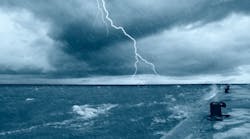Hurricane Sandy’s winds may have died down, but safety and health risks associated with cleanup and recovery remain in her wake. Dr. Caryl Heaton, chair of Family Medicine at the University of Medicine and Dentistry of New Jersey (UMDNJ) School of Osteopathic Medicine highlights some of the most pressing health and safety challenges that may surface after a major storm like Hurricane Sandy.
“There are a host of health concerns confronting residents as they begin cleaning up or returning to their homes,” said Heaton. “Contaminants in the environment could cause minor injuries or chronic illnesses to quickly intensify to the point that they could become life-threatening.”
Heaton outlined the following hazards and health conditions that threaten recovery efforts:
Musculoskeletal injuries. Water-soaked items will be both heavy and unwieldy, so work in tandem with others to move them. Lift with your legs and not your back. Instead of twisting your back when shoveling debris or carrying objects, pivot slowly on your feet and never attempt to throw heavy items or debris. Take frequent breaks to stretch muscles in the opposite direction from which they have been working. Treat sore muscles with over-the-counter medications, such as ibuprofen. Consult your physician if any soreness continues beyond a week, if any pain or numbness radiates from the lower back into the legs or if pain worsens when standing or walking.
Standing water. Much of the standing water that is left after Hurricane Sandy may be contaminated with fuel oil, pesticides or bacteria from sewage. Take precautions if you aren’t sure the water is clean. Cover as much of your body as you can with rubber gloves, waders or boots. Avoid letting cuts or open skin be touched contaminated water, but if they are, watch those sites carefully for infection, which include tenderness, redness of the skin and sometimes pus or clear fluid discharge. In cases of infection, check with your physician to see if you require antibiotic treatment.
Mold and mildew. As flood waters recede, mold and mildew can grow rapidly on surfaces. Any damp area may have increased mold and that can trigger allergy or asthmatic reactions. Even those individuals who have never had a history of asthma may find they have breathing difficulty when working to clean up storm damage. Your doctor can prescribe an inhaler to use in the short term for allergy associated asthma reactions.
Cardiac events. Not all chest tightness is allergy or asthma, however. Remember that central chest tightness is a symptom of heart attack. Anyone who gets chest tightness, shortness of breath or lightheadedness with vigorous activity (the kind required in this cleanup) should immediately stop and consider the possibility of heart disease. Sustained central chest tightness and pain that continues after the activity is over should be treated as a medical emergency.
Electric wires. Be careful with space heaters and electric lines. There is a chance of fire or electric shock as electric service is turned on and wires that were dead suddenly become “live.”
Household cleaners. Use only diluted bleach solutions (1 cup per gallon of water) when cleaning water-damaged surfaces and make sure the area you are cleaning is well ventilated. Never mix different types of cleaners as this can result in the release of harmful fumes. Take frequent fresh air breaks when using cleaners in enclosed spaces.
Stress. Because of the stress of this tragedy, many people will have less sleep, less warmth and a poor diet. Those factors can contribute to the normal colds and coughs we get this time of year. The vast majority of these are viral infections. The best way to prevent them is to get as much rest as you can and wash your hands frequently. Eat regular, balanced meals and pay special attention to remaining hydrated by drinking adequate amounts of water.
Medications. Be sure you have enough medication during and following an emergency like Hurricane Sandy. If you are running low on your medication, call your pharmacy first and see if you can get a refill. If you have no refills it’s a good idea to call and leave a detailed message at your doctor’s office with all contact and medical information carefully spelled out. Leave all your information – the name of the prescription (spelled out), the dose and how you take it, also be sure to spell your name and give your phone number, the pharmacy phone number and your date of birth. Many offices are overwhelmed with patients right now, and a simple request for a refill is easier than getting an appointment with the physician. This also allows your physician’s office to schedule more appointments for people who have new or worsening medical problems.
Wild or stray animals. Given the devastation throughout many areas, wild animals or former pets that have been displaced may be loose and present. Never approach a stray or wild animal, even one that appears to be injured. Instead, report the location of the animal to local authorities.
Finally, help each other by looking after your relatives, friends and neighbors.
“Don’t forget that simple acts of kindness can save lives,” said Heaton. “Help your neighbor, whether it’s with charging a cell phone or moving broken tree limbs. That’s safer for everyone.”

